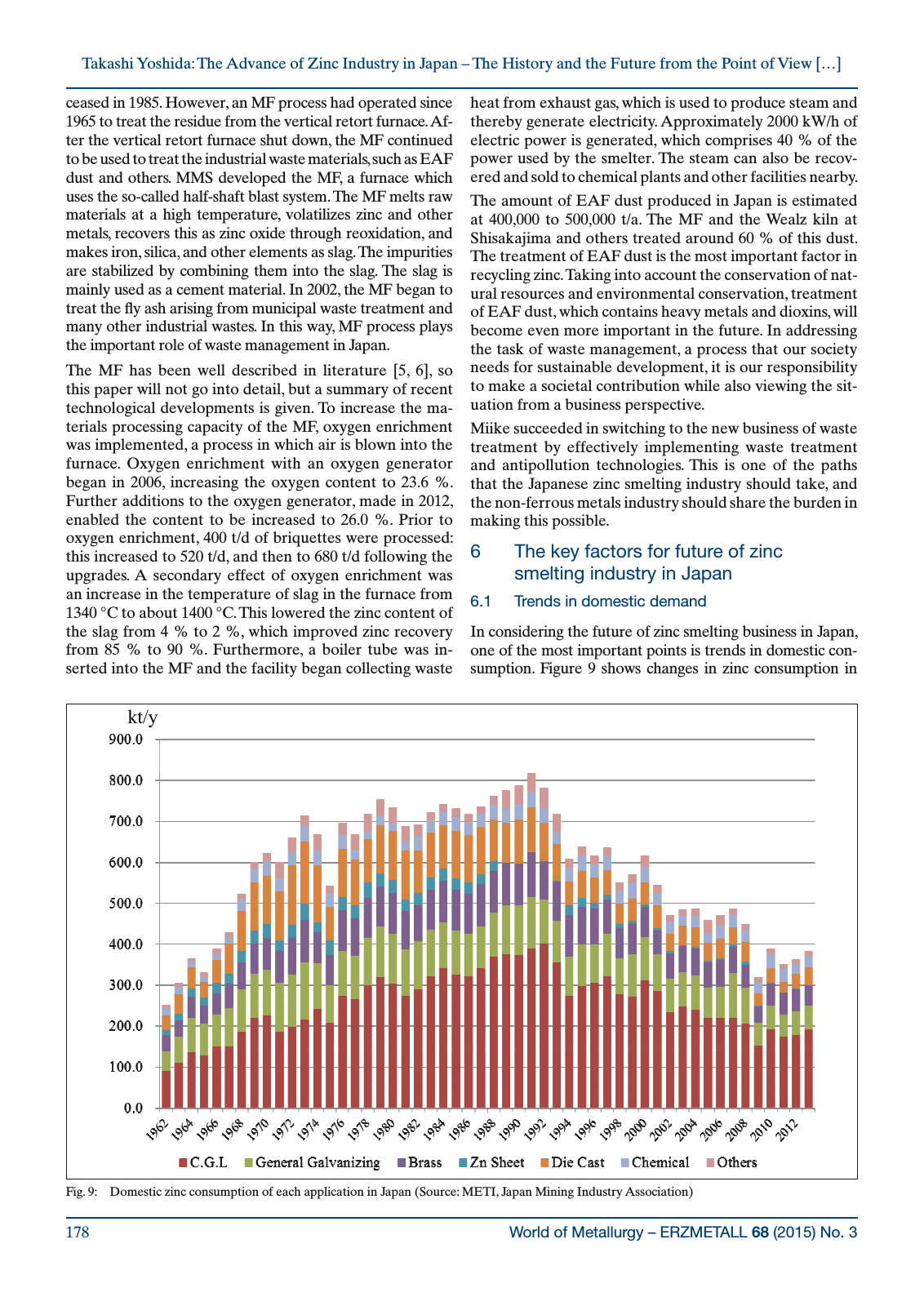World of Metallurgy ERZMETALL 68 2015 No 3178 Takashi Yoshida The Advance of Zinc Industry in Japan The History and the Future from the Point of View ceased in 1985 However an MF process had operated since 1965 to treat the residue from the vertical retort furnace Af ter the vertical retort furnace shut down the MF continued to be used to treat the industrial waste materials such as EAF dust and others MMS developed the MF a furnace which uses the so called half shaft blast system The MF melts raw materials at a high temperature volatilizes zinc and other metals recovers this as zinc oxide through reoxidation and makes iron silica and other elements as slag The impurities are stabilized by combining them into the slag The slag is mainly used as a cement material In 2002 the MF began to treat the fly ash arising from municipal waste treatment and many other industrial wastes In this way MF process plays the important role of waste management in Japan The MF has been well described in literature 5 6 so this paper will not go into detail but a summary of recent technological developments is given To increase the ma terials processing capacity of the MF oxygen enrichment was implemented a process in which air is blown into the furnace Oxygen enrichment with an oxygen generator began in 2006 increasing the oxygen content to 23 6 Further additions to the oxygen generator made in 2012 enabled the content to be increased to 26 0 Prior to oxygen enrichment 400 t d of briquettes were processed this increased to 520 t d and then to 680 t d following the upgrades A secondary effect of oxygen enrichment was an increase in the temperature of slag in the furnace from 1340 C to about 1400 C This lowered the zinc content of the slag from 4 to 2 which improved zinc recovery from 85 to 90 Furthermore a boiler tube was in serted into the MF and the facility began collecting waste heat from exhaust gas which is used to produce steam and thereby generate electricity Approximately 2000 kW h of electric power is generated which comprises 40 of the power used by the smelter The steam can also be recov ered and sold to chemical plants and other facilities nearby The amount of EAF dust produced in Japan is estimated at 400 000 to 500 000 t a The MF and the Wealz kiln at Shisakajima and others treated around 60 of this dust The treatment of EAF dust is the most important factor in recycling zinc Taking into account the conservation of nat ural resources and environmental conservation treatment of EAF dust which contains heavy metals and dioxins will become even more important in the future In addressing the task of waste management a process that our society needs for sustainable development it is our responsibility to make a societal contribution while also viewing the sit uation from a business perspective Miike succeeded in switching to the new business of waste treatment by effectively implementing waste treatment and antipollution technologies This is one of the paths that the Japanese zinc smelting industry should take and the non ferrous metals industry should share the burden in making this possible 6 The key factors for future of zinc smelting industry in Japan 6 1 Trends in domestic demand In considering the future of zinc smelting business in Japan one of the most important points is trends in domestic con sumption Figure 9 shows changes in zinc consumption in Fig 9 Domestic zinc consumption of each application in Japan Source METI Japan Mining Industry Association kt y

Hinweis: Dies ist eine maschinenlesbare No-Flash Ansicht.
Klicken Sie hier um zur Online-Version zu gelangen.
Klicken Sie hier um zur Online-Version zu gelangen.